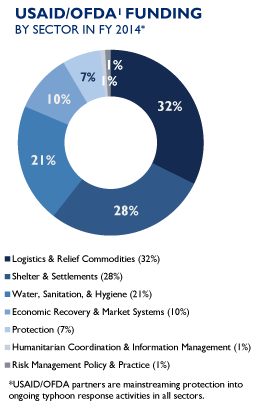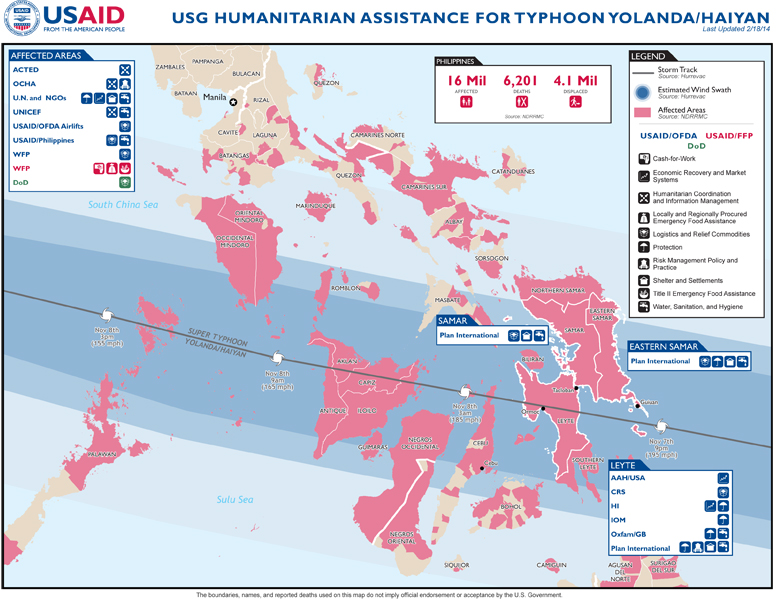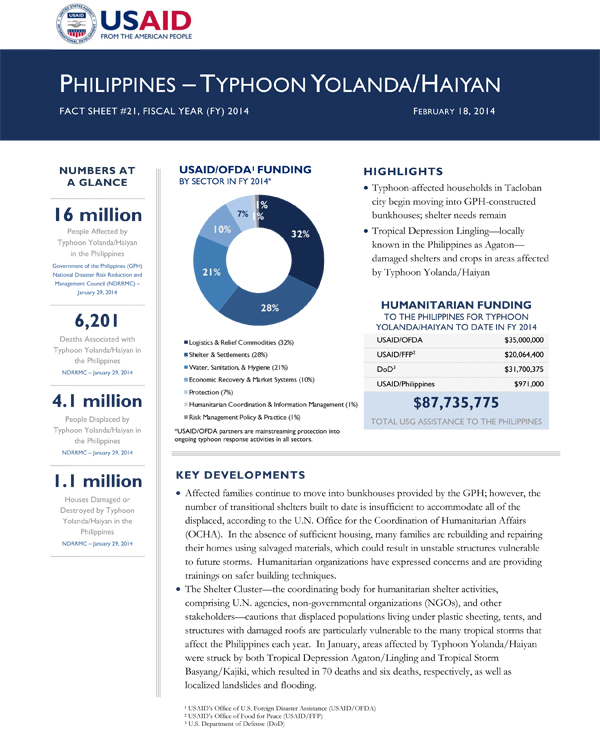- What We Do
- Agriculture and Food Security
- Democracy, Human Rights and Governance
- Economic Growth and Trade
- Education
- Ending Extreme Poverty
- Environment and Global Climate Change
- Gender Equality and Women's Empowerment
- Global Health
- Water and Sanitation
- Working in Crises and Conflict
- Disaster Assistance
- Political Transition Initiatives
- Conflict Mitigation and Prevention
- Countering Violent Extremism
- Disaster Risk Reduction
- Peacebuilding and Reconciliation
- Providing Safe & Secure Environments for Development
- Recovering From Crisis
- Resilience
- Tech Challenge for Atrocity Prevention
- World Humanitarian Day
- U.S. Global Development Lab
February 18, 2014
Philippines Typhoon Yolanda Program Map - 02-18-2014 ![]() (pdf - 2 MB)
(pdf - 2 MB)
Numbers At A Glance
16 million
6,201
4.1 million
1.1 million
Humanitarian Funding:
To The Philippines For Typhoon Haiyan/Yolanda To Date In FY2014:

| USAID/OFDA | $35,000,000 |
| USAID/FFP | $20,064,400 |
| DoD | $31,700,375 |
| USAID/Philippines | $971,000 |
| TOTAL | $87,735,775 |
Highlights
Typhoon-affected households in Tacloban city begin moving into the Government of the Philippines (GPH)-constructed bunkhouses; shelter needs remain.
Tropical Depression Lingling—locally known in the Philippines as Agaton—damaged shelters and crops in areas affected by Typhoon Yolanda/Haiyan
Key Developments
Affected families continue to move into bunkhouses provided by the GPH; however, the number of transitional shelters built to date is insufficient to accommodate all of the displaced, according to the U.N. Office for the Coordination of Humanitarian Affairs (OCHA). In the absence of sufficient housing, many families are rebuilding and repairing their homes using salvaged materials, which could result in unstable structures vulnerable to future storms. Humanitarian organizations have expressed concerns and are providing trainings on safer building techniques.
The Shelter Cluster—the coordinating body for humanitarian shelter activities, comprising U.N. agencies, non-governmental organizations (NGOs), and other stakeholders—cautions that displaced populations living under plastic sheeting, tents, and structures with damaged roofs are particularly vulnerable to the many tropical storms that affect the Philippines each year. In January, areas affected by Typhoon Yolanda/Haiyan were struck by both Tropical Depression Agaton/Lingling and Tropical Storm Basyang/Kajiki, which resulted in 70 deaths and six deaths, respectively, as well as localized landslides and flooding.
SHELTER AND SETTLEMENTS
Typhoon Yolanda/Haiyan damaged or destroyed an estimated 1.1 million homes across affected areas. The GPH plans to assist 600,000 affected households directly and has requested that humanitarian organizations address the shelter needs of the remaining 500,000 households, according to the Shelter Cluster. Shelter reconstruction efforts are ongoing, with the U.N. reporting that a lack of options for transitional and permanent housing is prolonging displacement in evacuation centers for many typhoon-affected people. In response, humanitarian organizations are improving conditions in evacuation centers by conducting repairs and installing kitchen areas and family partitions. OCHA reports that additional water, sanitation, and hygiene (WASH) facilities are needed in bunkhouses and transitional sites.
To date, the Shelter Cluster has provided close to 500,000 households with emergency shelter assistance, such as tents and plastic sheeting. More than 55,000 households have received tools and materials enabling them to repair their own homes safely. An estimated 40,000 families have received cash grants to purchase building materials and pay laborers, and an additional 2,000 families have received constructed houses that can be expanded based on family needs.
Recent severe weather has damaged or destroyed emergency shelters in some areas. Tropical Depression Agaton/Lingling damaged or destroyed approximately 1,400 tents—20 percent of the total number of tents—in Guiuan municipality, Eastern Samar Province, which was heavily affected by Typhoon Yolanda/Haiyan. Humanitarian partners are distributing relief commodities in the affected areas.
To date, humanitarian partners have provided most shelter assistance along coastal areas, and the Shelter Cluster recommends that humanitarian organizations improve targeting in order to reach vulnerable populations inland. Families living in GPH-designated no-build zones are also particularly vulnerable as they are at risk of multiple displacements.
LIVELIHOODS
The Philippines is the world’s second-largest coconut producer, accounting for more than 25 percent of global production in 2013. Typhoon Yolanda/Haiyan damaged or destroyed an estimated 33 million coconut trees, affecting the livelihoods of more than one million coconut farmers, according to the U.N. Food and Agriculture Organization and the Philippine Coconut Authority.
While farmers are replanting trees, newly planted coconut trees take six to eight years to reach maturity and return to full production, and the U.N. cautions that alternate livelihoods are urgently needed in the interim while coconut farmers wait for new trees to grow. OCHA reports that 60 percent of small-scale coconut farmers in the Philippines live in poverty and are at high risk of indebtedness if they do not receive livelihoods support.
Selling lumber from downed coconut trees is a potential source of short-term income; however, affected communities are currently unable to take full advantage of this due to a lack of chainsaws and sawmills in country. The wood from the downed trees will rot within six months, raising additional concerns about rotting wood leading to insect infestations.
HEALTH
The Ormoc City Health Office in Leyte Province is working with partners to develop a dengue fever plan of action after 84 suspected cases of dengue were reported in January, exceeding the alert threshold. Authorities have conducted spraying and fogging interventions in Ormoc and Tacloban cities, and humanitarian actors are conducting information campaigns regarding dengue prevention and treatment.
The GPH Department of Health (DoH) and the U.N. World Health Organization (WHO) conducted a measles immunization campaign between January 24 and 27 in Tacloban city, covering all barangays with suspected or confirmed measles cases. To date, health partners have immunized more than 78,000 children against measles in typhoon-affected areas. The U.N. Children’s Fund (UNICEF) reports nearly 100 new measles cases since the beginning of January, of which 60 percent were reported in Eastern Visayas Region and 40 percent in Western Visayas Region.
As of January 27, 25 foreign medical teams continued to operate in typhoon-affected areas of the Philippines. Of these teams, 13 were providing basic outpatient care; eight were providing mobile health clinics, mental health care, and psychosocial support; three were providing more advanced health services, including surgeries; and one was providing specialty services.
The DoH also has led interventions to provide psychosocial support. A total of 21 GPH psychiatrists have addressed psychosocial needs in typhoon-affected areas and coordinated support services with NGOs and private sector donors, according to the U.N. The Health Cluster also conducted a series of training of trainers on psychosocial first aid and disseminated printed guidelines to GPH representatives and humanitarian organizations.
AGRICULTURE AND FOOD SECURITY
Tropical Depression Agaton/Lingling destroyed ready-to-harvest crops in some areas affected by Typhoon Yolanda/Haiyan, exacerbating food security concerns.
Typhoon Yolanda/Haiyan damaged nearly 30,000 small-scale fishing boats, while more than 100,000 boats were lost or destroyed. Agriculture and food security partners are working to rehabilitate the livelihoods of farmers and fishers in typhoon-affected areas by providing seeds, fertilizer, and cash assistance.
Since the beginning of the emergency operation, the U.N. World Food Program (WFP) has reached more than 2.8 million beneficiaries through general food distributions, approximately 114,000 people through nutrition interventions, and more than 465,000 beneficiaries through cash transfers. As of February 13, WFP had dispatched more than 29,000 metric tons (MT) of food, including 28,468 MT of rice, 105 MT of specialized nutrition products, and 474 MT of high-energy biscuits (HEBs).
USAID/FFP has provided more than $20 million in food assistance to the Philippines since WFP's emergency operation began in November. USAID/FFP remains the largest contributor of food assistance to WFP's emergency operation to date. USAID/FFP support has included more than 6,000 MT of U.S.-sourced rice and 55 MT of U.S.-sourced emergency food products, including nutritional pastes and rice and wheat bars—valued at more than $8.6 million in total. In addition, USAID/FFP contributed $11.45 million for the local purchase of 2,400 MT of rice and 40 MT of supplemental HEBs, as well as support for cash-based programming, including cash-for-work, cash-for-assets, and cash transfer activities to help affected families purchase food in local markets. Through its contributions, USAID/FFP has provided critical food assistance reaching more than 3 million typhoon-affected people.
PROTECTION
The Protection Cluster is monitoring the relocation of more than 500 families into bunkhouses in Ormoc city. Cluster coordinators have expressed concerns about the protection risks associated with the close proximity of the bunkhouses and the lack of community consultations prior to construction. Protection Cluster focus group discussions have found that overall, people are comfortable moving into bunkhouses, though a small number of those surveyed expressed concerns that moving would limit livelihoods opportunities.
In the next three months, more than 70,000 births are expected in typhoon-affected areas, of which approximately 12 percent will be from mothers under 19 years of age. The Health Cluster reports a lack of partners working on reproductive health in some areas, including Ormoc.
INTERNATIONAL ASSISTANCE
As of February 18, international donors had pledged approximately $661 million to address the needs of populations affected by Typhoon Yolanda/Haiyan. The total amount pledged represents nearly 84 percent of the $788 million requested by the U.N.’s Strategic Response Plan for the Philippines.









Comment
Make a general inquiry or suggest an improvement.